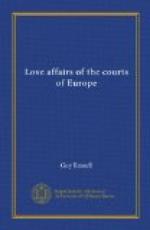Such then was the singularly contrasted couple—“Beauty and the Beast” they were dubbed by many—who stood together at the altar at Macerata on Good Friday of the year 1772—the bridegroom, “looking hideous in his wedding suit of crimson silk,” in flaming contrast to the virginal white of his pretty victim. It needed no such day of ill-omen as a Friday to inaugurate a union which could not have been otherwise than disastrous—the union of a beautiful, romantic girl eager to exploit the world of freedom and of pleasure, and a drink-sodden man old enough to be her father, for whom life had long lost all its illusions.
It is true that for a time Charles Edward was drawn from his bottle by the lure of a pretty and winsome wife, who should, if any power on earth could, have made a man again of him. She laughed, indeed, at his maudlin tales of past heroism and adventure in love and battle; to her he was a plaster hero, and she let him know it. She was “mated to a clown,” and a drunken clown to boot—and, well, she would make the best of a bad bargain. If her husband was the sorriest lover who ever poured thick-voiced flatteries into a girl-wife’s ears, there were others, plenty of them, who were eager to pay more acceptable homage to her; and these men—poets, courtiers, great men in art and letters—flocked to her salon to bask in her beauty and to be charmed by her wit.
After all, she was a Queen, although she wore no crown. She had a Court, although no Royalties graced it. From the Pope to the King of France, no monarch in Europe would recognise her husband’s kingship. But at such neglect, the offspring of jealousy, of course, she only smiled. She could indeed have been moderately happy in her girlish, light-hearted way, if her husband had not been such an impossible person.
As for Charles Edward, he soon wearied of a bride who did nothing but laugh at him, and who was so ready to escape from his obnoxious presence to the company of more congenial admirers. He returned to his brandy bottle, and alternated between a fuddled brain and moods of wild jealousy. He would not allow his wife to leave the door without his escort; if she refused to accompany him, he turned the key in her bedroom door, to which the only access was through his own room.
He took her occasionally to the theatre or opera, his brandy bottle always making a third for company. Before the performance was half through he was snoring stertorously on the couch which he insisted on having in his box; and, more often than not, was borne to his carriage for the journey home helplessly drunk. And this within the first year of his wedded life.
If any woman had excuse for seeking elsewhere the love she could not find in her husband it was Louise of Albany. There were dames in plenty in Rome (where they were now living) who, not content with devoted husbands, had their cisibeos to play the lover to them; but Louise sought no such questionable escape from her unhappiness. Her books and the clever men who thronged her salon were all the solace she asked; and under temptation such as few women of that country and day would have resisted, she carried the shield of a blameless life.




